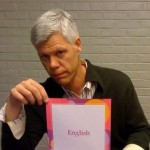Join Bryan Dean and Les Howard as they discuss what education means with a small group of junior high school students. The students share what they find helpful–and what they don’t find helpful–in the classroom.
Engagement: Conducting a Symphony of Learning in the Classroom
Notes from the Classroom Oakland Writing ProjectA conductor stands in front of an orchestra. He raises his arms and there is silence in the concert hall. When he brings his arms down, music begins. Each instrument plays his or her own part in creating a larger musical production. The conductor hears the music and directs the players, but he does not play every instrument. How wonderful it would be if we were conductors in our classrooms!
Each year, I find myself in front of a new group of sixth grade students — fresh new faces, some with no idea how good they are at playing music. Some of the music will be beautiful, some will create dissonance in their lives and in the community. And, you know what? It’s okay. Together, eventually, we will create a whole new community — one that will encourage independent thinking so that each member can solve problems and have an open forum for discussion.
However, right now, we are not there yet. As always, with the first couple of assignments, there’s always a Dion who asks “Is this right?”, “Should I ……?” (fill in the blank with whatever decision necessary). When I ask, “tell me what YOU think…” they look at me as though I have suddenly grown three heads. I turn, take a deep breath, and think, “Okay, here we go, it’s September!”
Sometimes, whether I intend to or not, I give the impression that I am, as the teacher, the purveyor of all information, of every note and instrument, and my way is THE way. What I really want my students to do is to theorize and contemplate ideas they have and synthesize the information that they discover. However, when my students begin to play their part in the music, sometimes I try to “fix” it. It does not take much for students to become disengaged when they feel that their voices are not valued. Imagine the conductor ignoring an entire group of instruments…
I want to teach my students. I want them engaged! However, engagement requires that I actually teach them from my own places of vulnerability and openness. Do I mind being wrong or not having all of the information or do I feel that I must play each instrument to get it right? What if there is another way to solve a problem? Am I open to seeing and hearing their music? To teach my students well, I must listen to their thoughts and ideas. I must work to break down the barriers between us that suggest that there is one “right” way.
Every year, the instruments in my “classroom orchestra” are played by different musicians, each talented in a different way than the ones before. There are a variety of ways to encourage students’ “music.” For example:
- Practice not answering any question that students can answer for themselves. This goes for most of the questions that students ask in the beginning of the year. I model the manner in which I want them to question each other – “I wonder if …..”, “what do you think will happen if ……”, “do you think that will work?” Then, I get ready for incorrect answers.
- Allow the incorrect answers. In the places where a discussion can take place, I ask students what they think about both correct and incorrect answers. Students end up discussing their answers. This is my opportunity for modeling and discussing different ways of “talking to” without “talking at.” Here, I can build trust and listen to student thinking.
- Trust is imperative. Our students must trust us and we must trust our students enough to allow a level of autonomy in the classroom. This is not a haphazard learning environment where everyone “goes on their own.” It is a highly structured environment where students are free to speak and think aloud and reason with others, openly discussing their ideas.
- Allow students to discover their way through learning by hypothesizing and testing. I have had to let go of the feeling that they will not “get it” or will not be able to discern the “right” way if I do not “help” them. Me releasing control of the “how” and “why” has been the key to opening the door to a greater level of engagement for my students.
Our students and their reasoning should be given respect–even if it is not the way we think. Dion can learn to think and reason aloud with the rest of his classmates if we respect him enough to hear him play. That respect is the key. For all that we hope to accomplish, we should know that we must be open and willing to “let go” and allow students agency–the ability to make choices to explore–in their learning. That way, we become conductors of a symphony where we do not play every instrument. We understand, we listen, and we conduct the music.
 Marcia Bonds is a 6th Grade Math and English Language Arts Teacher at Key School in the Oak Park School District. She has been teaching for 17 years. Marcia is a member of the Core Leadership Team of the Oakland Writing Project and was a co-facilitator of the 2014 Oakland Writing Project Summer Institute. She has facilitated professional development on inquiry-based learning for the Oak Park School District.
Marcia Bonds is a 6th Grade Math and English Language Arts Teacher at Key School in the Oak Park School District. She has been teaching for 17 years. Marcia is a member of the Core Leadership Team of the Oakland Writing Project and was a co-facilitator of the 2014 Oakland Writing Project Summer Institute. She has facilitated professional development on inquiry-based learning for the Oak Park School District.
Audience is Everything
Notes from the Classroom Oakland Writing ProjectIn my first post, I said I was in an alumni production of Our Town. Now, the play is over, and the reviews are in. Wilder’s play survived my assault on Doc Gibbs, but the experience has me thinking about teaching writing.
Audience is everything.
 Different disciplines define “audience” using other words, but it all comes down to the perception and experience of the end user. All products, all successful products, are designed with the user in mind, as determined by product testing or a focus group. Art and music, while often very personal, succeed when they “find and audience.” Sketching, journaling, and playing random chords because they please you is fine because you are the only audience. But if you want to find out if you’re good, however that’s defined, you need an audience.
Different disciplines define “audience” using other words, but it all comes down to the perception and experience of the end user. All products, all successful products, are designed with the user in mind, as determined by product testing or a focus group. Art and music, while often very personal, succeed when they “find and audience.” Sketching, journaling, and playing random chords because they please you is fine because you are the only audience. But if you want to find out if you’re good, however that’s defined, you need an audience.
What’s the measure of success in writing? Did it achieve the writer’s goal with her intended audience? As a teacher, I know that my goal is for my students to be successful actors in the play that we call writing. I am both the director as I guide them through the process, and a participant as I write alongside them. But where’s our audience? Who are we working so hard for? How do we know if our choices are the right ones if we never get to see the audience, hear them laugh in the first two acts, and then go silent in the third because we set them up for that on purpose?
When we rehearsed Our Town, our only audience was each other and the director. We ran our lines and worked through how to deliver them, but we had no idea how they’d be received by an actual audience. There were places that we suspected would be funny or poignant if we delivered the lines well, but we didn’t really know if they would work as we expected them to. There were words and phrases that we had to say, either because another character depended on hearing them as a cue to deliver another line or because they were vital to delivering some thematic idea. We had to be fast and bright in the first two acts because we planned to shock the audience with our somber tone in the third.
The director helped us imagine our audience and what they would see and hear, but that’s not the same thing as having an audience. The whole endeavor, the play, was aimed at the audience, not me. I was having fun, but the audience was who I was working for. When we did perform the play, we knew where it worked because we could see and hear the audience react. It was a rush when we got it right, and it stung when it fell flat, but at least we knew for sure what the audience thought.
That idea lingers.
 In the past couple of years, I have been putting more and more emphasis on the importance of audience in writing. I talk with my students about who their audience is, its characteristics, what moves it, and recently, we talked about what might delight the audience. The mantra “when you write for everyone, you write for no one” echoes through my room as we try to imagine that one person we’re trying to reach. (I know who it is for this piece.)
In the past couple of years, I have been putting more and more emphasis on the importance of audience in writing. I talk with my students about who their audience is, its characteristics, what moves it, and recently, we talked about what might delight the audience. The mantra “when you write for everyone, you write for no one” echoes through my room as we try to imagine that one person we’re trying to reach. (I know who it is for this piece.)
The problem is–it’s fake. There is no audience, not really. We give excellent feedback to each other, but it isn’t the same thing as having an audience. I had been aware of that, but until I walked across a stage and delivered my lines for a real audience, I didn’t feel it. I do now, keenly. The question becomes: where do I get an audience for my students?
My students have been blogging for years, and my use of new media platforms has evolved from a place for me to make announcements to a static discussion board to a place where my students can engage each other. But the audience is still “us,” the theater company. We are currently setting up blogs on Tumblr. This will be our third year on that site, and I have a decent sense of how to use it to talk about 21st century writing, but my goal this year is to try and get my students’ best work in front of a real audience. I’m not entirely sure what that will look like or if I can accomplish it. Is this something I can do using Tumblr blogs, or is that still too insulated?
Peer feedback is another option I’m working hard on, but again, it doesn’t feel-big enough. When I was at an NCTE Conference, I saw a presentation on having a Writers Week, but that’s a ton of prep for really only one week. I’m looking for help here, gentle reader. If you have a suggestion, please share it. I want my students to feel the sting of missing a line, or having something they think will work fall flat, and then come back with a better idea. I want them to know their writing has succeeded, not because I gave them an “A,” but because they can hear the laugh and see the audience cry a little in the third act.
 Rick Kreinbring teaches English at Avondale High School in Auburn Hills, Michigan. His current assignments include teaching AP Language and Composition and AP Literature and Composition. He is a member of a statewide research project through the Michigan Teachers as Researchers Collaborative partnered with the MSU Writing in Digital Environments Program, which concentrates on improving student writing and peer feedback. Rick has presented at the National Advanced Placement Convention and the National Council of Teachers of English Conference. He is in his twenty-third year of teaching and makes his home in Huntington Woods.
Rick Kreinbring teaches English at Avondale High School in Auburn Hills, Michigan. His current assignments include teaching AP Language and Composition and AP Literature and Composition. He is a member of a statewide research project through the Michigan Teachers as Researchers Collaborative partnered with the MSU Writing in Digital Environments Program, which concentrates on improving student writing and peer feedback. Rick has presented at the National Advanced Placement Convention and the National Council of Teachers of English Conference. He is in his twenty-third year of teaching and makes his home in Huntington Woods.
